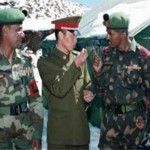Contrary to India, China thinks in terms of the “˜dual use for its infrastructure”¦ infrastructure projects such as airports and railways should be designed to also serve war-time needs.
The Chinese media has, however, forgotten important ‘details’ while reporting the opening of the tunnel. The place is so remote that for centuries no one knew if the mighty Brahmaputra was flowing towards South-East Asia like Mekong or Irrawaddy to Burma… or to India? During the 19th century, the British thought that the best way to ‘conquer’ the sub-continent was to map it; they were, however, left with this enigma. The Great Trigonometrical Survey, the ancestor of the Survey of India often sent ‘locals’ (they called them ‘pundits’) for surveying these remote Himalayan areas. One of these ‘pundits’ was Kintup, alias KP, a native of Sikkim. He travelled to Tibet to chart the course of Yarlung Tsangpo.
KP could not reach Metok, but tried to throw marked logs down the stream of Tsangpo and see if they would reach India. Unfortunately, nobody got his message and when he returned to Assam in 1884 (after four years on the mountain tracks), Yarlung Tsangpo and Brahmaputra were still two different rivers. It is only several years later that the Survey found some of the logs in Bengal and that KP became famous.
For Tibetans, it is one of the most pristine regions of their country. They consider the area around the ‘Great Bend’ of Brahmaputra as the home of Goddess Dorjee Pagmo, Tibet’s ‘Protecting Deity’. Many believe that Pemakoe is the sacred realm often referred to in their scriptures: the last hidden Shangrila. It is also said that the great Indian tantric master, Padmasambhava, visited the place during the eighth century and tamed the local spirits to conceal scriptures for future generations.
The region unlike other parts of Tibet receives plenty of rain and within the Great Bend area one finds the rarest species of flora and fauna. Though not yet fully documented, the Chinese authorities admit that the region is home for more than 60 per cent of the biological resources of Tibet.
Also read: Police cannot take on Maoists
But the particularly bad news for India is that the engineers who have worked for the northward diversion of the waters of Yarlung Tsangpo across hundreds of kilometres of mountainous regions to China’s north-western provinces of Xinjiang and Gansu, have planned the main hydropower plant in Metok area. The gorges of Brahmaputra can provide one of the greatest hydropower potentials available in the world. For South Asia and more particularly for India, the enormity of the scheme and its closeness to the Indian border cannot be ignored. It will of course be a political decision, but the new road makes it now practically conceivable. The road will not only trigger the disappearance of one of the last sacred places of this planet, but will also have strategic and military consequences for India.
Contrary to India, China thinks in terms of the ‘dual use’ for its infrastructure. Mr Xi Jinping, the future party boss (he takes over in 2012) is a great supporter of Chairman Mao Tse-tung’s theory of “the synthesis between the requirements of peacetime and war.” For Mao, civilian sectors had always a major role to play in military preparedness. For example, infrastructure projects such as airports and railways should be designed to also serve war-time needs.
Some years ago, when Mr Xi Jinping was party secretary of Zhejiang province, he had said, “We must implement (Mao’s) strategic concept of the ‘unity between soldiers and civilians’ and both the Army and regional civilian authorities should assiduously pool our resources in the preparation for military struggle against China’s enemies.” The new road will clearly serve more purposes than is being claimed.




